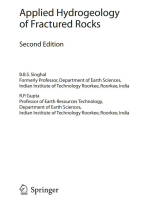Добрый день, Коллеги. Важное сообщение, просьба принять участие. Музей Ферсмана ищет помощь для реставрационных работ в помещении. Подробности по ссылке
Applied hydrogeology of fractured rocks / Прикладная гидрогеология трещиноватых горных пород
More than half of the surface area of the continents is covered with hard rocks of low permeability. These rocks may acquire moderate to good permeability on account of fracturing and hence are broadly grouped under the term fractured rocks, in the context of hydrogeology. The importance of systematic hydrogeological studies in fractured rocks was realised by the international community about 50years back when an international symposium was held at Dubrovink in the erstwhile Yugoslavia (UNESCO-IAHS 1967). Such studies have gained greater importance in recent years as is evidenced by several special publications and international seminars and workshops sponsored by IAH, IAHS, IGC and other organisations, world-over (e.g. Wright and Burgess 1992; Sheila and Banks 1993; NRC 1996; IAH 2005; Ronka et al. 2005; Witherspoon and Bodvarsson 2006; Krasny and Sharp 2008). US Geological Survey has been carrying out detailed field and model studies on the characterisation of fluid flow and chemical transport in fractured rocks (Shapiro 2007; also see websites: http://water.usgs.gov/nrp/proj.bib/hsieh.html; http://toxics.usgs.gov; http://water.usgs.gov/ogw/bgas/).Hard rocks including igneous, metamorphic and strongly cemented sedimentary rocks and carbonate rocks cover about 50% of the earth’s land surface i.e. approximately 30million km2 including extensive areas in several continents. In several developing countries of Asia, Africa and Latin America, greater emphasis is being given to supply safe drinking water to the vast population living in hard rock terrains. For abbreviations/acronyms see list of Abbreviations.This has necessitated evolving efficient and economic methods of groundwater exploration, assessment and development. In this context, integrated geological, remote sensing and geophysical methods have proved very successful. Further, disposal of solid and liquid wastes is an important problem in both developing and developed countries which has threatened water quality, and for this purpose low-permeability rocks form the targets. Therefore, special attention is required to locate suitable sites for the safe disposal of such waste, especially high-level waste (HLW) (Witherspoon and Bodvarsson 2006). <...>




